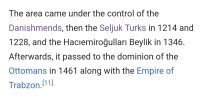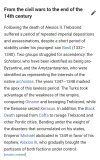Hello everyone, and welcome to the seventh edition of Tinto Maps! I am once again asking for your support back to the duty of showing a new region of the map of the super secret Project Caesar, which this week is Anatolia!
Countries:

A beautifully divided Anatolia! The disintegration of the Sultanate of Rûm in the 13th century, caused by the Mongol invasion, led to multiple Turkish Beyliks grabbing power over their area. Probably the strongest in 1337 is the Ottoman one, founded by the Turkoman leader Osman Ghazi, but there are other strong contenders such as the Eretnids, the Germiyanids, or the Karamanids, which will be fighting for hegemony over the region. You might also notice that the Byzantine Empire//Eastern Roman Empire//Basileía Rhōmaíōn//[insert here your favorite naming option] still holds a few positions in Anatolia, the most notable being the city of Philadelphia. Apart from them, other interesting countries in the region are the Despotate of Trebizond, held by the Komnenoi, the Armenian Kingdom of Cilicia, and, of course, The-country-known-in-another-IP-as-Hisn-Kayfa, the Ayyubid remnant in al-Jazira. And you might also notice some Genoese outposts, making them important players as well.
Dynasties:

The dynastic map is pretty straightforward, as a different dynasty rules each Beylik. We have fixed the issue with the random dynasty names, so no more weird 'the XXXX of XXXX' dynastic names anymore. To spice things up, we could maybe start a Byzantine discussion: Palaiologos, or Komnenos?
Locations:

As usual, please consider that dynamic location naming is not yet a thing in this region, and therefore the inconsistencies in the language used. As an additional note of caution, please don’t use the Aegean Islands as a reference or benchmark for comparison, as a review of them is something that we’ve got on our list of ‘to do’. You may be able to see that the location density in the region is gradual, from denser coastal regions to bigger inland ones.
Provinces:

We have changed the coloring of the provinces, making them more different, and easier to understand, though. Apart from that, suggestions in this matter are welcomed, as usual.
Terrain:



The terrain in Anatolia is quite interesting and unique, as it’s composed of very different features: the central Anatolian Plateau, with a colder climate and more sparse vegetation, is opposed to the rugged and more forested coastlines to the north and south, while only having fluvial flatlands to the west, and in Cilicia (an area that always has been a choke point between Anatolia and Syria. And to the east, the territory becomes increasingly more mountainous, as it approaches the Caucasus.
Cultures:

Anatolia is the first region of the Middle East with cultural and religious minorities added, just in time for this Tinto Maps, so we can have endless discussions about the divide between the Greek and Turkish cultures! Hurray! Now seriously, we’ve made what we think is the most accurate division for 1337, given the scarcity of data. The stripes point to a variation of the pop percentages in each location, from let’s say 70% of Greeks in Izmit or Bursa, to 80% of Turks in Ankara or Konya. We have also added some subdivisions of these cultures, with the Pontic and Cappadocian Greeks; and the Turkomans (you might note a majority of them around Sivas and Malatya), that portray more a ‘class//social grouping’ divide than an ethnic or language divide, as these Turkoman pops are always tribesmen, while we consider the settled population as Turkish. Other than that, we have a good amount of Armenians distributed between the areas of Cilicia and Armenia; Laz people to the north; and Kurds to the east (the brownish-greenish culture). Also, please ignore the chunk of Syria that appears, as the minorities there are not yet done.
Religions:

We’re back to interesting religious divisions! We have in Anatolia Orthodox, Sunni, Miaphysite, and Nestorian pops. And if you wonder what are those pink stripes in Thrace, they are a Paulician minority.
Raw Materials:

There are some interesting materials distributed all over Anatolia, such as Alum (which was a main export to Italy, usually handled by the merchant republics), Silk, Marble, or Copper. And if you’re wondering about the Spices, they were previously Saffron.
Markets:

The market centers of the region are Constantinople to the west, Trebizond to the north, and Damascus to the south. Nothing speaks against a Turkish Beylik conquering one or all of them, or creating a new market center, probably in the middle of the Anatolian Plateau, although probably it will require some infrastructure to make it fully functional.
Location and Country Population:


And populations. Byzantium has some edge over each of the Beylikz, but not if they ally with each other, or if they ally with its Balkanic rivals… Also, have I heard about a 66K Ayyubid challenge?
That’s all for today! We’ll most likely be uploading the French feedback results by the end of next week or at the start of the following one (as next week there's an important bank holiday for this company,Midsommar St. John's Day, and some people will be on vacation a few days), and in the meantime, we'll also be reading and answering your feedback about Anatolia. And next Friday, we will be taking a look at Russia. See you then!
PS: I had a flight today that was delayed, therefore the delay on the DD until an (interesting) hour in which I'll be available for replying.
Countries:

A beautifully divided Anatolia! The disintegration of the Sultanate of Rûm in the 13th century, caused by the Mongol invasion, led to multiple Turkish Beyliks grabbing power over their area. Probably the strongest in 1337 is the Ottoman one, founded by the Turkoman leader Osman Ghazi, but there are other strong contenders such as the Eretnids, the Germiyanids, or the Karamanids, which will be fighting for hegemony over the region. You might also notice that the Byzantine Empire//Eastern Roman Empire//Basileía Rhōmaíōn//[insert here your favorite naming option] still holds a few positions in Anatolia, the most notable being the city of Philadelphia. Apart from them, other interesting countries in the region are the Despotate of Trebizond, held by the Komnenoi, the Armenian Kingdom of Cilicia, and, of course, The-country-known-in-another-IP-as-Hisn-Kayfa, the Ayyubid remnant in al-Jazira. And you might also notice some Genoese outposts, making them important players as well.
Dynasties:

The dynastic map is pretty straightforward, as a different dynasty rules each Beylik. We have fixed the issue with the random dynasty names, so no more weird 'the XXXX of XXXX' dynastic names anymore. To spice things up, we could maybe start a Byzantine discussion: Palaiologos, or Komnenos?
Locations:

As usual, please consider that dynamic location naming is not yet a thing in this region, and therefore the inconsistencies in the language used. As an additional note of caution, please don’t use the Aegean Islands as a reference or benchmark for comparison, as a review of them is something that we’ve got on our list of ‘to do’. You may be able to see that the location density in the region is gradual, from denser coastal regions to bigger inland ones.
Provinces:

We have changed the coloring of the provinces, making them more different, and easier to understand, though. Apart from that, suggestions in this matter are welcomed, as usual.
Terrain:



The terrain in Anatolia is quite interesting and unique, as it’s composed of very different features: the central Anatolian Plateau, with a colder climate and more sparse vegetation, is opposed to the rugged and more forested coastlines to the north and south, while only having fluvial flatlands to the west, and in Cilicia (an area that always has been a choke point between Anatolia and Syria. And to the east, the territory becomes increasingly more mountainous, as it approaches the Caucasus.
Cultures:

Anatolia is the first region of the Middle East with cultural and religious minorities added, just in time for this Tinto Maps, so we can have endless discussions about the divide between the Greek and Turkish cultures! Hurray! Now seriously, we’ve made what we think is the most accurate division for 1337, given the scarcity of data. The stripes point to a variation of the pop percentages in each location, from let’s say 70% of Greeks in Izmit or Bursa, to 80% of Turks in Ankara or Konya. We have also added some subdivisions of these cultures, with the Pontic and Cappadocian Greeks; and the Turkomans (you might note a majority of them around Sivas and Malatya), that portray more a ‘class//social grouping’ divide than an ethnic or language divide, as these Turkoman pops are always tribesmen, while we consider the settled population as Turkish. Other than that, we have a good amount of Armenians distributed between the areas of Cilicia and Armenia; Laz people to the north; and Kurds to the east (the brownish-greenish culture). Also, please ignore the chunk of Syria that appears, as the minorities there are not yet done.
Religions:

We’re back to interesting religious divisions! We have in Anatolia Orthodox, Sunni, Miaphysite, and Nestorian pops. And if you wonder what are those pink stripes in Thrace, they are a Paulician minority.
Raw Materials:

There are some interesting materials distributed all over Anatolia, such as Alum (which was a main export to Italy, usually handled by the merchant republics), Silk, Marble, or Copper. And if you’re wondering about the Spices, they were previously Saffron.
Markets:

The market centers of the region are Constantinople to the west, Trebizond to the north, and Damascus to the south. Nothing speaks against a Turkish Beylik conquering one or all of them, or creating a new market center, probably in the middle of the Anatolian Plateau, although probably it will require some infrastructure to make it fully functional.
Location and Country Population:


And populations. Byzantium has some edge over each of the Beylikz, but not if they ally with each other, or if they ally with its Balkanic rivals… Also, have I heard about a 66K Ayyubid challenge?
That’s all for today! We’ll most likely be uploading the French feedback results by the end of next week or at the start of the following one (as next week there's an important bank holiday for this company,
PS: I had a flight today that was delayed, therefore the delay on the DD until an (interesting) hour in which I'll be available for replying.
















